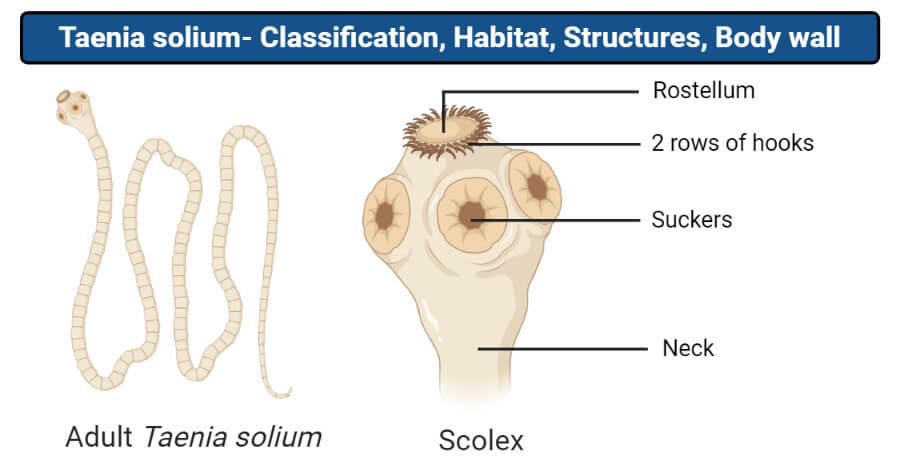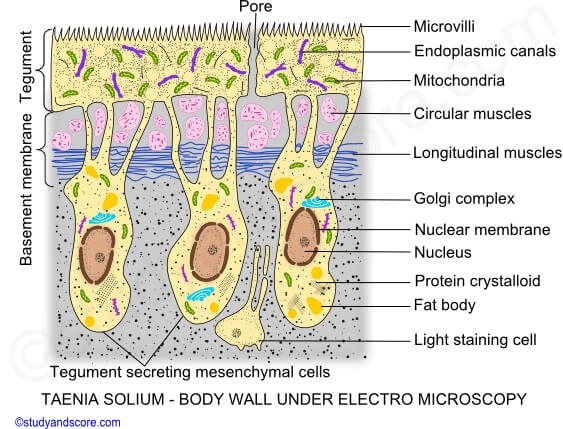Classification of Taenia solium
| Phylum | Platyhelminthes |
| Class | Cestoda |
| Subclass | Eucestoda |
| Order | Taenioidea |
| Genus | Taenia |
| Species | solium |
Habits and Habitat of Taenia solium
- Taenia solium, also known as pork tapeworm, is found worldwide. Thus, its distribution is cosmopolitan.
- Its adults dwell in man’s small intestine as an internal parasite, i.e., endoparasitic, where it adheres to the intestinal mucosa by its scolex.
- Its life cycle is completed in two hosts, i.e., digenetic, man as the primary host, and pig as a secondary host.
- Other animals like goats, cattle, monkeys, and horses also serve as intermediate hosts.
- It is especially reported from the European countries where pork is eaten, either raw or improperly cooked.
- It absorbs the host’s digestive food through its body wall.
Structure of Taenia solium

1. Shape, size, and coloration
- It is usually opaque white, but creamish, yellowish, or greyish coloration is also common.
- Its body is long (1-5 meters), dorsoventrally flattened, narrow, ribbon-like.
- The two flat surfaces represent the dorsal and ventral surfaces, respectively.
- The internal view reveals that the surface closer to the testes is dorsal, and nearer to the female reproductive organs is the ventral surface.
- Its body narrows anteriorly and gradually broadens posteriorly.
2. Segmentation
- The elongated body of the tapeworm is divided into many segments or parts with about 850, called proglottids.
- Segmentation of tapeworms is called pseudometamerism.
- The tapeworm body is divisible into three distinct parts anterior scolex or head, a short-unsegmented neck, and a segmented strobila.
3. Scolex
- It is present at the anterior end of the body.
- It is knob-like, biradially symmetrical, and 0.6 mm to 1 mm wide.
- It appears roughly quadrangular in the en-face view.
- It is smaller than the head of a pin, about 1mm in diameter.
- It consists of four cup-like muscular suckers having radial muscles.
- At its tip is a prominent rounded mobile cone, the rostellum.
- Rostellum is armed with 22 to 32 curved and chitinous hooks in 2 circles, the inner circle with larger hooks and the outer ring with smaller ones.
- Large hooks each measures 14 to 0.18 mm, and those small each measures 0.11 mm to 0.14 mm.
- Each hook consists of a base by which it fixes, a handle directed towards the apex, and a conical blade directed outwardly.
- Four hemispherical highly muscular suctorial organs, true suckers or acetabula, are present on the scolex’s broadest part.
- It is the organ of attachment to the intestinal mucosa with its suckers and hooks. Thus, it is an organ of adhesion or the holdfast.
4. Neck
- Behind, the scolex, well-defined, short, narrow, and unsegmented region present, the neck.
- It has been variously termed the budding zone, growth zone, area of proliferation, and segmentation area because it grows continuously and proliferates proglottids by transverse fission or asexual budding.
5. Strobila
- The neck is followed by the flattened, ribbon-like body, the strobila.
- It forms the main bulk of the body.
- It consists of 800 to 1,000 segments or proglottids arranged in a linear series in a chain-like fashion.
- The strobila of mature tapeworm measures about 3 meters in length.
- A proglottid is a unit parts of the body enclosing a complete set of genitalia and surrounding tissue.
- The linear arrangement or repetition of these units is called proglottisation.
- The proglottids, internally, remain connected together by muscles, excretory vessels, and nerve cords.
- Proglottids are independent, self-contained units, each with a complete set of male and female reproductive organs and a part of the excretory and nervous system.
- Proglottids are budded off from the neck region and pushed back due to more proglottids in front.
- Anterior proglottids are youngest in strobila, and posterior ones are oldest.
- The proglottids are differentiated into three kinds according to the degree of development.
a. Immature proglottids
- These are proglottids just behind of neck.
- These include nearly 200 anterior proglottids.
- They are the youngest, sexually immature, and devoid of reproductive organs.
- They are short, broader than long, and rectangular in outline.
b. Mature proglottids
- They form the middle part of the strobila.
- They are about 450 in number.
- These are large and squarish in outline.
- The anterior 100 to 150 proglottids contain male reproductive organs only.
- The posterior 250 proglottids develop both male and female reproductive organs. Thus, mature proglottids are hermaphrodite.
c. Gravid proglottids
- These are the oldest and towards the posterior end of the body.
- They include 150 to 350 proglottids.
- They are .onger than broad in outline.
- They have no reproductive organs.
- They contain only branched uterus packed with fertilized eggs.
The proglottids of strobila widen gradually along their length from the anterior to the posterior one. The proglottids bear genital papilla and pore, alternating once to the right and then to the left.
Apolysis
- Small groups of gravid proglottids are regularly cut off from the posterior end of strobila and pass out with the host’s feces, called apolysis.
- Apolysis serves to transfer the developing embryos to the exterior, where the secondary hosts can ingest them.
- It also keeps the body’s size, which may otherwise attain enormous length due to the continued proliferation of new proglottids from the neck region.
Body wall of Taenia solium
The tapeworm lacks a cellular or ciliated epidermis. The body wall of Taenia consists of an Outer tegument and inner basement membrane. The basement membrane includes both the musculature and the packing material called parenchyma.

Image Source: Study and Score.
1. Teguments
- It is the outermost, thick, waxy, and enzyme resistant layer clothing the body in the absence of a cellular epidermis.
- It is derived from the tegumentary secretory cells.
- It is composed of protein impregnated with calcium carbonate and is perforated by numerous fine canals.
- It consists of three layers outermost hair-like of finger-like comidial layer, the middle thick homogenous layer, and the innermost basement membrane.
- The studies done by Threadgold and others have shown that the outermost cuticle is an intact thick, living, and syncytial layer called tegument.
- The tegument is derived from the tegumentary secretory cells.
- The tegument is connected to the tegumentary secreting cells with strands of cytoplasm called trabeculae.
- It contains mitochondria and lysosomes and gives out microvilli-like processes called microtriches, on its outer surface.
- The microvilli help in increasing the surface area of absorption of a nutritive substance from the host and also acts as holdfast organs.
- The tegument is helpful in protecting the inner parts of the body.
- The tegument is perforated by minute pores t through which substances are absorbed from the host’s intestine.
2. Integumentary musculature
- It is situated just below the basement membrane.
- It consists of an outer circular and inner longitudianl fibers.
- The mesenchymal musculature consists of longitudinal, transverse, or circular, and vertical or dorsoventral muscle fibers.
3. Mesenchyme or parenchyma
- The tegument is followed by mesenchyme.
- It is a syncytial network formed by branched mesenchymal cells.
- It consists of loosely-packed cells with fluid-filled interspaces, forming packing substances around the internal organs.
- It does not contain a body cavity.
- The parenchyma in young proglottids and neck region is thicker and some free cells which later differentiate to form the reproductive organs.
- The turgidity of fluids helps to maintain the form of the body and it also acts as a hydraulic skeleton.
- It contains numerous round or oval calcareous bodies composed of concentric layers of calcium carbonate which is secreted by the special mesenchymal lime cells.
- The secretion from the lime cells helps to neutralize the acid of the digestive juice of the host.
- circular muscle fibers at the margins, divide the mesenchyme into an outer cortex or cortical zone and inner medulla or medullary zone.
- Parenchyma also helps in the transport of substances to tissue in absence of a blood vascular system.
References and Sources
- Kotpal RL. 2017. Modern Text Book of Zoology- Invertebrates. 11th Edition. Rastogi Publications.
- Jordan EL and Verma PS. 2018. Invertebrate Zoology. 14th Edition. S Chand Publishing.
- 3% – http://c-4-c.com/tenia-solium-77/
- 2% – https://www.toppr.com/ask/question/dropping-of-gravid-proglottids-by-cestodes-is-called-as/
- 2% – https://www.studyandscore.com/studymaterial-detail/taenia-general-characters-body-wall-nutrition-respiration-excretion-and-nervous-system
- 2% – https://www.biologydiscussion.com/invertebrate-zoology/phylum-platyhelminthes/taenia-solium-habitat-structure-and-life-history/28918
- <1% – https://www.sciencedirect.com/topics/immunology-and-microbiology/cestoda
- <1% – https://www.sciencedirect.com/science/article/pii/S0065308X08601773
- <1% – https://www.guwsmedical.info/reproductive-biology/physical-characteristics-hxx.html
- <1% – https://www.bartleby.com/topics/taenia-solium
- <1% – https://socratic.org/questions/how-does-the-structure-of-villi-allow-efficient-absorption-in-the-small-intestin
- <1% – https://quod.lib.umich.edu/p/philamer/ACT3868.0056.001?rgn=main;view=fulltext
- <1% – https://pediaa.com/difference-between-male-and-female-reproductive-system/
- <1% – https://julib.fz-juelich.de/vufind/Record/54078
- <1% – https://answers.yahoo.com/question/index?qid=20090531161615AAjgZaC
- <1% – https://animaldiversity.org/accounts/Sepioteuthis_sepioidea/
